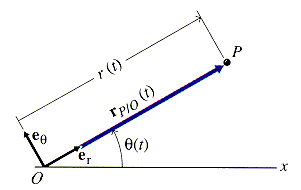
Polar (Radial/Transverse) Coordinates
This coordinate system is convenient to use when the distance and direction of a particle are measured relative to a fixed point or when a particle is fixed on or moves along a rotating arm.

Coordinates are chosen such that:
- er is a unit vector pointing radially outward from the origin toward the particle, and
- e
is a unit vector pointing perpendicular to the radial line in the direction of increasing
.

Note that
er = cos ![]() i + sin
i + sin ![]() j
j
e![]() = -sin
= -sin ![]() i + cos
i + cos ![]() j
j
Therefore, position of the particle in polar coordinates is given by
![]()
velocity of the particle is given by

and acceleration is given by

Again, velocity will always be tangent to the path, and acceleration will generally have components both normal and tangent to the path.